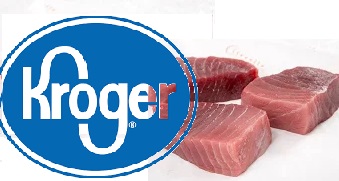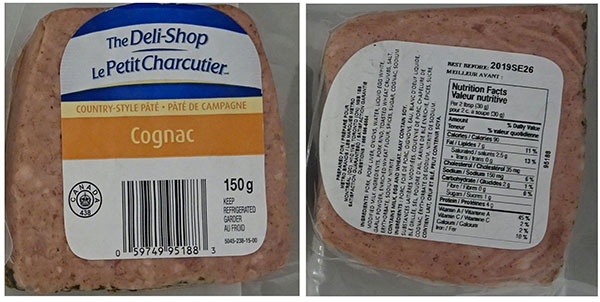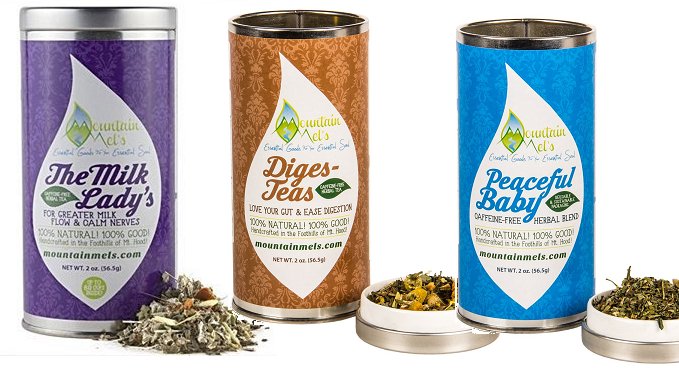On September 4, 2019, the FDA became aware of multiple scombroid (Scombroid fish poisoning, or histamine fish poisoning, resembles an allergic reaction that occurs after eating fish contaminated with high levels of histamine) poisoning cases in individuals who consumed tuna steaks purchased from three separate Kroger retail locations in Ohio. As a result, the FDA is advising consumers not to eat yellowfin tuna steaks from Kroger retail stores. Kroger agreed to remove all yellowfin tuna steaks from their stores in AL, AR, GA, IL, IN, KS, KY, MI, MO, MS, NE, OH, SC, TN, VA and WV as well as begin notifying consumers who had purchased this product to dispose of or return the product to the store. The tune with sell-by dates from August 29, 2019, and September 14, 2019, were sold as raw yellowfin tuna steaks at the seafood counter or seasoned in store-prepped Styrofoam trays. @ https://www.fda.gov/food/alerts-advisories-safety-information/fda-advises-consumers-not-eat-yellowfin-tuna-steaks-kroger-retail-stores-multiple-states?utm_campaign=Alert_Tuna_09072019&utm_medium=email&utm_source=Eloqua
On September 4, 2019, the FDA became aware of multiple scombroid poisoning in individuals who consumed tuna steaks purchased from three separate Kroger retail locations in Ohio.
ruth
In a recent study conducted by Pennsylvania State University and published in Microbiome volume 7, 21 August 2019 the researchers showed that a packing facility with a significantly higher Listeria monocytogenes presence had biofilm formation by the Pseudomonadaceae and the fungal family Dipodascaceae that protected the Listeria. The lack of proper drainage, poor cleaning, and sanitation protocols have contributed to the unique microbiota in the built environment of the facility and the biofilm formation. Pseudomonadaceae and Dipodascaceae predominate in the facility and represent microorganisms that are known biofilm formers and indicators of unhygienic conditions, respectively. Biofilm formation may support L. monocytogenes persistence in this facility due to the protection offered by the biofilm. Bacteria such as Pseudomonadaceae may help foodborne pathogen such as L. monocytogenes in survival and persistence in food processing environments and thus increase the food safety and public health risk. @ https://microbiomejournal.biomedcentral.com/articles/10.1186/s40168-019-0726-2
Multistate foodborne disease outbreaks and recalls of apples and apple products contaminated with Listeria monocytogenes demonstrate the need for improved pathogen control in the apple supply chain. Apple processing facilities have been identified in the past as potential sources of persisting L. monocytogenes contamination. In this study, we sought to understand the composition of microbiota in built apple and other tree fruit processing environments and its association with the occurrence of the foodborne pathogen L. monocytogenes. Analysis of 117 samples collected from three apple and other tree fruit packing facilities (F1, F2, and F3) showed that facility F2 had a significantly higher L. monocytogenes occurrence compared to F1 and F3 (p < 0.01). The microbiota in facility F2 was distinct compared to facilities F1 and F3 as supported by the mean Shannon index for bacterial and fungal alpha diversities that was significantly lower in F2, compared to F1 and F3 (p < 0.01). Microbiota in F2 was uniquely predominated by bacterial family Pseudomonadaceae and fungal family Dipodascaceae. The composition and diversity of microbiota and mycobiota present in the investigated built food processing environments may be indicative of persistent contamination with L. monocytogenes. These findings support the need for further investigation of the role of the microbial communities in the persistence of L. monocytogenes to support the optimization of L. monocytogenes control strategies in the apple supply chain.
ruth
Les Spécialités Prodal (1975) Ltée is recalling The Deli-Shop brand Pâtés including Country-style Pâté (Cognac, Pepper, Old Fashioned), and Liver Pâté (Fine Herbs, garlic and Old Fashioned) from the marketplace due to possible Listeria monocytogenes contamination. This recall was triggered by the Canadian Food Inspection Agency (CFIA) test results. The CFIA is conducting a food safety investigation, which may lead to the recall of other products. There have been no reported illnesses associated with the consumption of these products. @ https://www.inspection.gc.ca/about-the-cfia/newsroom/food-recall-warnings/complete-listing/2019-08-30/eng/1567201658590/1567201658898
Les Spécialités Prodal (1975) Ltée is recalling certain The Deli-Shop brand Pâtés from the marketplace due to possible Listeria monocytogenes contamination.
ruth
The FDA posted on their website that Mountain Mel’s Essential Goods, LLC of Welches, OR recalled The Milk Lady’s Tea, Peaceful Baby Herbal Tea, and Diges Herbal Tea, due to potential contamination with Salmonella. The Milk Lady’s, Peaceful Baby, and Diges-Teas were distributed in Oregon and Washington through New Seasons Market, and nationwide through Azure Standard, Mountainmels.com and Amazon.com. The affected tea products were distributed by Mountain Mel’s Essential Goods on June 27, 2019, and July 20, 2019. No illnesses have been reported to date. The recall is due to fennel seed whole that was supplied and recalled by Mountain Rose Herbs in Oregon and included in the recalled teas. Mountain Mel’s Essential Goods has ceased production and distribution of this product as of July 20, 2019. @ https://www.fda.gov/safety/recalls-market-withdrawals-safety-alerts/mountain-mels-essential-goods-llc-recalls-milk-ladys-herbal-tea-blend-peaceful-baby-herbal-tea-blend?utm_campaign=Mountain%20Mel%E2%80%99s%20Essential%20Goods%2C%20LLC%20Recalls%20The%20Milk%20Lady%E2%80%99s%20Herbal%20Tea%20Blend&utm_medium=email&utm_source=Eloqua
Mountain Mel’s Essential Goods, LLC of Welches, OR is recalling The Milk Lady’s Tea with LOT # ML6271950, Peaceful Baby Herbal Tea with LOT # PB781950, and Diges-Teas Herbal Tea with LOT # DT7619100, because it has the potential to be contaminated with Salmonella, an organism which can cause serious




